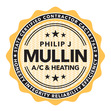An air conditioner has three main parts, a compressor, a condenser, and an evaporator. The compressor and the condenser are usually located outside, and the evaporator is located inside. The Freon arrives at the compressor as a cool, low-pressure gas. The compressor compresses, or squeezes, the gas turning it into a hot, high-pressure gas. This gas then flows to the condenser.
The condenser is the part that has metal fins all around. These fins help the heat dissipate quickly, and a fan blows it away. When the Freon leaves the condenser, it is much cooler and has changed from a gas to a liquid.
The liquid Freon enters the evaporator through a very tiny hole. This causes the Freon's pressure to drop, and it begins to change into a gas and evaporate taking heat from the air around it. By the time the Freon leaves the evaporator, it is, once again, a cool, low-pressure gas ready to start the trip again.
The evaporator also has metal fins and a fan. The fan blows the inside air across the fins, and the heat is removed from the air. The air is much cooler and is then blown throughout the house via the duct work.
This process repeats again and again until the desired temperature is reached.

 RSS Feed
RSS Feed

